24 July 2015
The Sun’s radius (695,500km) is approximately 110x larger than that of the Earth (6,367km). But compared to other stars in the cosmos, even the Sun looks tiny. One of the largest known stars is VY Canis Majoris, which has a radius of 987,600,000km (1420x the Sun). That means its total volume is 2.86 billion times larger than the Sun. VY Canis Majoris is so large it would engulf all the planets up to and including Jupiter.
Source: https://youtu.be/HEheh1BH34Q
#ScienceGIF #Science #GIF #Star #Stellar #Earth #Planets #Sun #Astronomy #Physics #Scale #Size #Enormous
View Original Post on Google+

23 July 2015
Scientists at the U.S. Department of Energy’s Argonne National Laboratory have developed a system for levitating individual droplets of liquid using sound waves. Two speakers are positioned opposite one another and used to create a standing wave in the air between. When the drops of liquid are placed into the system, they fall into the nodes of the standing wave. If the acoustic pressure is strong enough, the drops of liquid will remain “stuck” in the nodes of the standing wave and levitate in the air.
Source: https://youtu.be/669AcEBpdsY
#ScienceGIF #Science #GIF #Acoustics #Pressure #Physics #Node #StandingWave #NationalLab #Sound
View Original Post on Google+
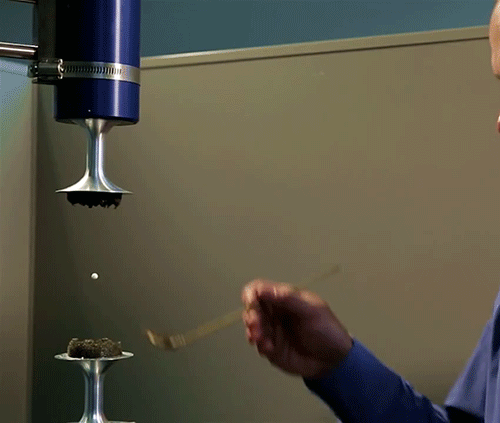
22 July 2015
On July 12, 2012 there was an enormous eruptive event on the Sun captured by NASA’s Solar Dynamics Observatory. It consisted of three parts: a solar flare, a coronal mass ejection, and coronal rain.
A solar flare is a sudden flash of brightness on the Sun ‘s surface corresponding to the release of enormous amounts of energy. Solar flares are often accompanied by a coronal mass ejection , which is a burst of gas and magnetic fields launched into space from the surface of the Sun. Coronal rain occurs when hot plasma in the corona cools, condenses, and falls back towards the Sun in the strong magnetic fields surrounding solar flares.
Source: https://youtu.be/HFT7ATLQQx8
#ScienceGIF #Science #GIF #Sun #Solar #SolarFlare #CoronalMassEjection #CME #CoronalRain #Coronal #Corona #SolarDynamicsObservatory #NASA #Space #Star #Physics #Fusion
View Original Post on Google+
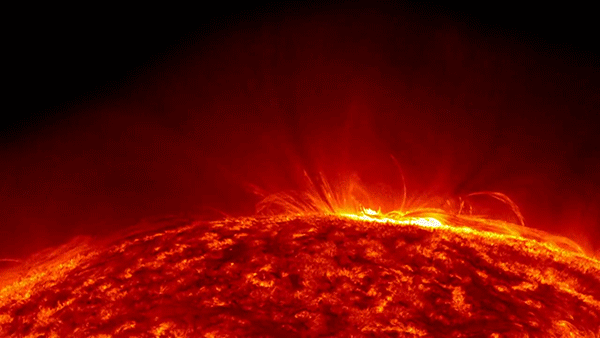
20 July 2015
This is an HD-resolution Earthrise video taken from lunar orbit by the Japanese lunar orbiter SELENE (Selenological and Engineering Explorer). The probe is nicknamed Kaguya after the legendary Japanese moon princess. This imagery was captured as the orbiter passed over the lunar south pole with the sun directly behind the probe.
Source: https://youtu.be/H1KWtG66lEQ (JAXA)
#ScienceGIF #Science #GIF #Space #Earth #Moon #Lunar #JAXA #Japan #Earthrise #Exploration #Discovery #Orbiter
View Original Post on Google+
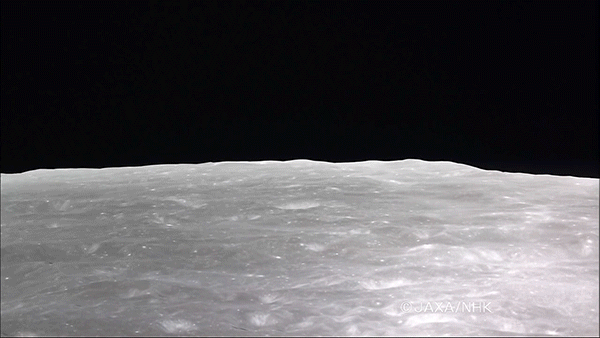
17 July 2015
This 360-degree visualization of the surface of Pluto was generated by a YouTuber from imagery taken by NASA’s New Horizons spacecraft during its recent #PlutoFlyby . The three-dimensional# surface detailed was extracted from a two-dimension image using a technique called photoclinometry. Also known as “shape-from-shading,” it uses the shadows and light direction as reference points to construct a 3D bump map from an otherwise 2D image. Newer satellites use a two-camera (or two lens) technique called stereoscopy to achieve more accurate three dimensional perspectives.
Source: https://youtu.be/37TNyDHZExA
#ScienceGIF #Science #GIF #Pluto #NewHorizons #Imagery #Photoclinometry #ImageProcessing #3D #Rotation #Camera #Surface #Mountains
View Original Post on Google+

15 July 2015
A team of scientists at IBM Research used a scanning tunneling microscope (STM) to generate and record a stop-motion animation composed of individual carbon monoxide atoms molecules. A conventional light microscope cannot be used to image individual atoms since they are much smaller than the wavelength of light and therefore unresolvable. An STM uses an extremely sharp metal needle to scan over a surface while recording changes in electrical current, which indicates the presence of an atom. The same metal needle can be used to push around individual atoms, which is how each frame of the animation was created. The resulting atoms in the animation are magnified over 100 million times their original size.
Source: http://ibmresearchnews.blogspot.com/2013/05/how-to-move-atom.html (IBM Research)
#ScienceGIF #Science #GIF #Physics #Imaging #Microscopy #STM #IBM #Research #StopMotion #Movie #Scanning
View Original Post on Google+
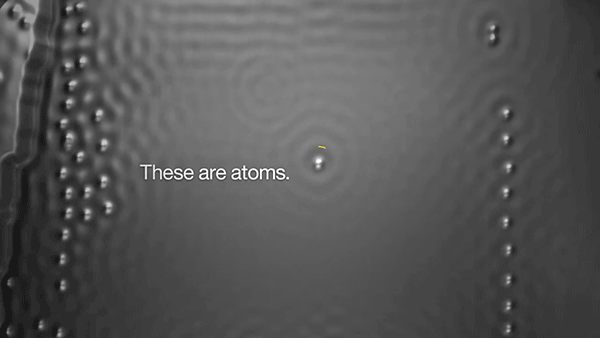
14 July 2015
At 7:49AM ET the New Horizons spacecraft performed its flyby maneuver past our outermost (known) dwarf planet Pluto and its largest moon Charon. The probe is expected to pass by at at roughly 30,800mph within 7,800 miles of the former planet and 17,900 miles from Charon. Because of the 3+ billion mile distance to Earth, radio signals take ~4.5hrs to reach researchers on the ground. NASA will not know the fate of the spacecraft until later today since collision with orbiting debris is a dangerous possibility.
This simulation of the flyby is from NASA’s Eyes on the Solar System visualization software.
Source: http://www.nasa.gov/mission_pages/newhorizons/main/index.html
#ScienceGIF #Science #GIF #NewHorizons #PlutoFlyby #Pluto #charon #NASA #Spacecraft #SolarSystem #Exploration #Camera #SpaceProbe #Space
View Original Post on Google+

14 July 2015
Pluto was discovered on February 18, 1930, by Clyde W. Tombaugh at the Lowell Observatory in Flagstaff, Arizona. Since then many pictures have been taken but none as stunning as the incoming imagery from NASA’s New Horizons spacecraft. Even the mighty Hubble Space Telescope could only capture blurry representations of the ninth-largest and tenth-most-massive known object orbiting the Sun.
This might seem contradictory because Hubble can capture brilliant, crisp images of galaxies thousands and millions of light years away. One has to remember that these distant objects are immense whereas Pluto is extremely tiny in comparison. When Hubble takes a picture of Pluto, it only occupies about 2.5 pixels in the image whereas an entire galaxy could fill the entire field of view!
Source: https://twitter.com/NASAGoddard/
#ScienceGIF #Science #GIF #Pluto #Imaging #Telescope #Satellite #PlutoFlyby #NewHorizons #Space #NASA #Astronomy
View Original Post on Google+
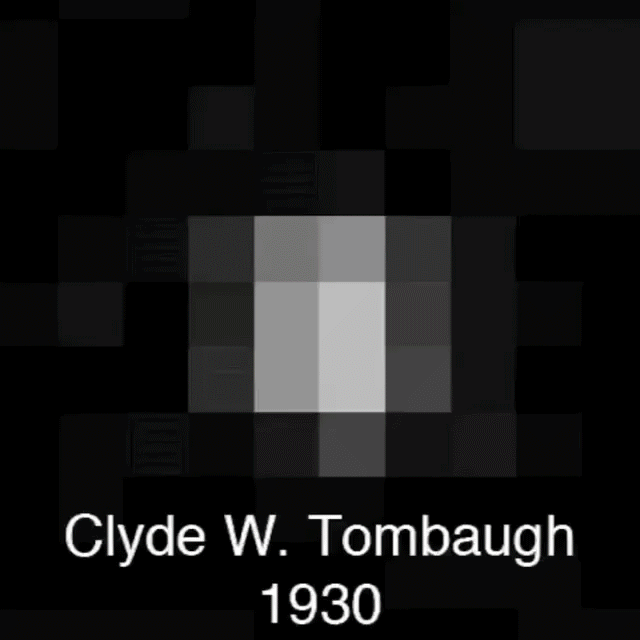
13 July 2015
After over 9 years of travel, NASA’s New Horizons spacecraft will finally perform its flyby of Pluto tomorrow morning. The first close-up photos of the dwarf planet and now-confirmed largest object in the Kuiper Belt will be anxiously awaited by the entire team on Earth. When launched in January 19, 2006, the spacecraft set a record 36,373mph for the highest launch speed of a human-made object from Earth. On February 28, 2007, New Horizons passed Jupiter during a gravity assist to further increase the speed another 9,000mph.
At the time of posting, the spacecraft was only a measly 480,000 miles away (compared to the 4.87 billion miles between Earth and Pluto). After passing Pluto the spacecraft will continue its extra-solar trek by studying other Kuiper Belt objects. Be sure to check out NASA’s live coverage of the event tomorrow!
http://www.nasa.gov/mission_pages/newhorizons/main/index.html
Source: https://youtu.be/kzyrBIySPWw
#ScienceGIF #Science #GIF #NewHorizons #Pluto #PlutoFlyby #NASA #Exploration #Charon #Earth #Spacecraft #SolarSystem #Orbit #Flyby
View Original Post on Google+

10 July 2015
This simulation from NASA’s Global Modeling and Assimilation Office depicts the transport of aerosols around the Earth between September 2006 - April 2007. Aerosols play an important role in both weather and climate by scattering and reflecting solar and terrestrial radiation. The simulation was conducted on the GEOS-5 system using data collected from various NASA satellites.
The different colors indicate different types of aerosols: dust is orange/red, sea salt is blue, organic and black carbon with green to yellow to white, and sulfates with ash brown to white. The yellow and red dots are wildfires and/or human-initiated burns detected by NASA’s Terra and Aqua satellites.
The most substantial aerosol releases are the dust (red) blowing westward from the Sahara Desert and the organic releases (green) from the rainforests of South America and Africa. The black carbon released from wildfires appears as white smoke. It’s fascinating to see the global wind patterns create ornate twirls with the sea salt aerosols.
Source: http://gmao.gsfc.nasa.gov/research/aerosol/modeling/nr1_movie/ (NASA GMAO)
#ScienceGIF #Science #GIF #Earth #Atmosphere #Climate #Aerosol #Transport #NASA #GMAO #Simulation #Planet #Model #Weather
View Original Post on Google+











